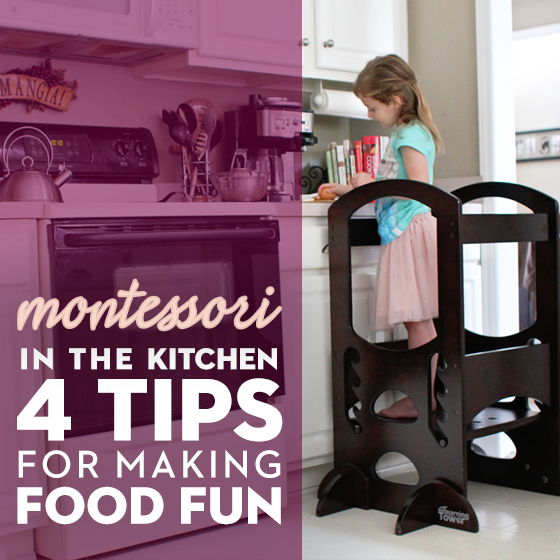The kitchen. It’s the one place in a household that is usually off-limits to little ones. Ovens, knives, glassware… the list of fearful items goes on and on. Let us not forget the added mess that is inevitable when a child helps you prepare a meal. But, meal preparation and kitchen play is actually one of the best learning scenarios for your child, giving them a chance to learn not only how to prepare food (an important life skill), but also the importance of nutritional value and what to eat. Food manipulation – in all of its messy glory – is also one of the best ways to get your picky child to try something new! Thus, we’ve incorporated the highly sought out Montessori method, or learning through self-exploration, to make the home kitchen accessible and enjoyable for all. Check out our tips for making food fun!
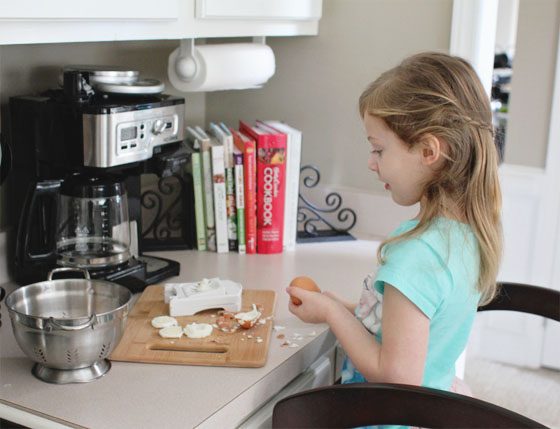
The Montessori approach focuses heavily on your child’s natural physiological, emotional, social, and physical development. One of the tenets of the Montessori educational approach is to make the home accessible to little ones so that they can learn through self-exploration and independence. By making the home kitchen accessible to children, allowing them to naturally be a part of the food preparation and cooking process, children can safely learn how to use their senses to their advantage, handle food, and build valuable, practical life skills that will serve them — and you — as they grow.
If you are new to the Montessori concept, handing over the kitchen duties to a young child might seem a little scary. We get it, but by setting up parameters and letting your child direct their own activity with independence and a hands-on approach, you’ll be amazed by what your child can accomplish. You may even ignite a new passion in your child (a nightly sous-chef sounds amazing!).
1. Enlist cool kitchen gadgets
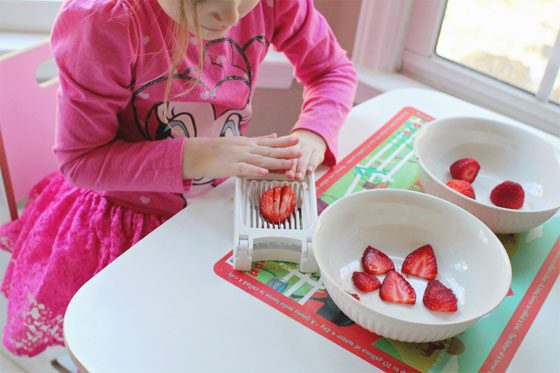
Our kitchens are full of fun gadgets that are usually off limits to little hands. But, bust out the potato peelers, apple cutters, strainers, cheese grater, spatulas, egg slicer, and funnels, and incorporate them into a fun food lesson for children in the kitchen! Using kitchen gadgets for food prep not only helps develop a child’s fine motor skills, but also gives them a hands-on approach to how food is made, what it is made of, and sometimes where it comes from.
Grating a hard block of Parmesan cheese into a fine dusting for tonight’s pasta dinner, or slicing a hard boiled egg in an egg slicer for a big Cobb salad shows children how food transforms from one shape to another and from one simple item used for a new purpose. Children love to transfer items from one place to another, watching the vast amount of food in one bowl lessen and lessen until another is filled. Even filling a pitcher of water and allowing your child to try pouring the water into individual cups to be served at the family dinner helps them grasp an important skill at an early age that otherwise is usually done for them for fear of messy spills.
While the list of fun kitchen gadgets for kids is long, start by sticking to one at a time so that your child has a chance to master it before moving onto another. Also, don’t be afraid to up the fun and have your child create with their new tools. Apple slicers are great for making apple slinkies, and using an egg slicer with strawberries can produce a number of beautiful floral works using all the various shapes of a thinly sliced strawberry.
Keep these on hand for fun food prep:
- Mortar and Pestle
- Hand-held juicer
- Mini grater
- Spice grinder
- Potato masher
- Whisk
- Nut cracker
- Rubber scraping spatula
- Vegetable brush
- Hand mixer
- Banana slicer
- Egg slicer
- Apple slicer
- Sifter
2. Provide a space of their own
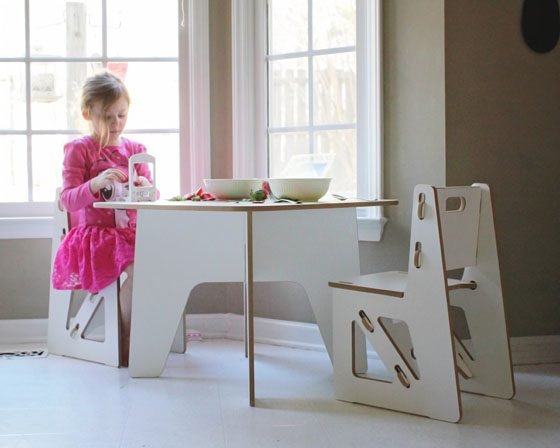
While most of the action in the kitchen takes place amongst the counter tops, many important skills can be taught around the dinner table as well. Setting the table, spooning out servings, eating with proper utensils, and cleaning up after ourselves are all important life skills that kids can learn early on. Rather than having your child work around the average kitchen table, provide them with their own space, perfect for their own size. Being able to reach the table, pull out their own chairs, and have full access to their own little area in the kitchen gives them more independence and self-confidence in completing a task. This is especially important when things are likely to get messy! There is nothing better than a kids’ table that can be easily assembled, placed anywhere in the home for easy access, and wipes clean with little fuss.
Product Recommendation
The Sprout Modern Kids Table and Chairs is the perfect set that will meet all of your child’s needs, as well as your own. When you are teaching table setting techniques or preparing strawberries for a simple fruit salad snack, the Sprout Modern Kids Table can be easily set up within minutes without the use of tools, and it features a washable melamine finish that makes spills a breeze and stains non-existent.

Cleaning up is so easy that children will also enjoy taking on the responsibility of wiping it down – a practical life skill that will serve you and your child well for years to come. You may also be surprised by how much your child will enjoy cleaning up when given the reigns of a spray bottle (chemical-free cleaner advised!).
Montessori Table Activities:
- Setting the table
- Napkin folding
- Serving food
- Pouring drinks
- Water table activities: Play with bowls and sponges, transfer water from one bowl to another with a baster, pour water into a bottle using a funnel.
- Sorting silverware
- Using silverware, such as a butter knife to spread butter on bread
- Cleaning the table
- Arranging flowers for a centerpiece
3. Make it accessible (within boundaries)

Kitchens are often inaccessible to children due to high counters and cabinetry, making it very hard for little hands to help prepare food, wash and dry dishes, or even help put away dishes from the dishwasher. With little accessibility, a child has very little opportunity to gain self-confidence in the kitchen. Because of this, a very popular kitchen staple in a Montessori home is the learning tower.
Product Recommendation
A learning tower, such as the Little Partners Original Learning Tower, makes kitchen counters and sinks accessible to small children while keeping their safety in mind first. Unlike the common household stool, the Little Partners Learning Tower is adjustable according to your child’s height from 18 months up to 6 years, so that your child meets the countertop at just the right level. Learning towers are also enclosed 360 degrees, keeping your child safely inside without the chance of slipping or falling. While that alone is a parent’s dream, the learning tower also prohibits your child from moving out of their designated space at the counter or kitchen sink, unlike a standard stool that can be easily moved by a young child.
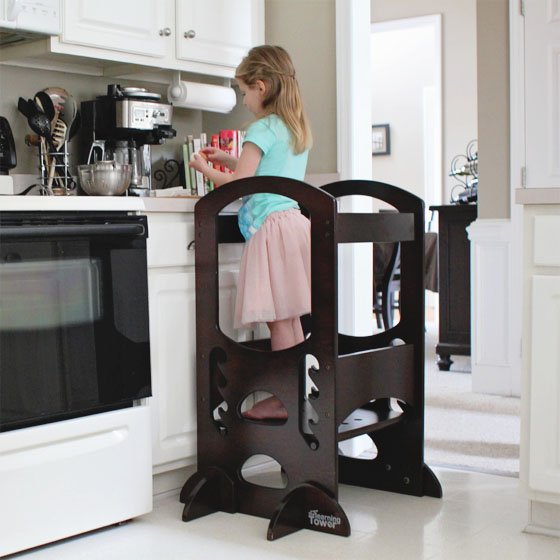
One of our favorite things to do with the Little Partner’s Learning Tower is prepare food! Part of the Montessori way is learning through a child’s senses. Setting up the Learning Tower at the kitchen sink and providing your child with all the tools they may need, such as a strainer and new batch of fresh berries, not only allows your child to properly learn how to wash fruit, but the child can also play with the water to find the right temperature, learning the difference between hot and cold. While it may be a little messy with splashing water at first, your child will learn how to maneuver the faucet to adjust the water speed as well as how to use the strainer to contain the solids and release the liquids. In just one simple act of washing berries, your child has already learned so much about the world around them and is taking huge steps to becoming independent.
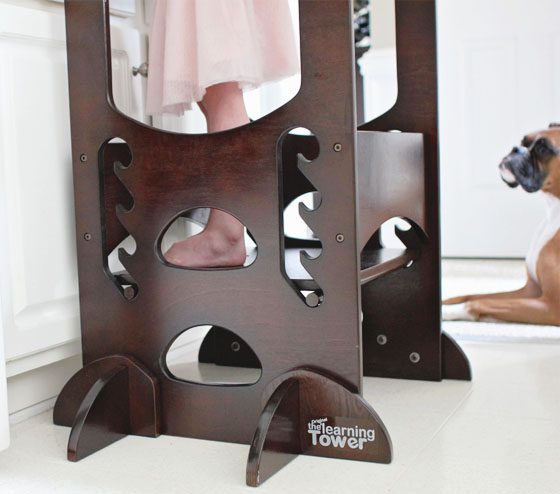
SHOP
Little Partners Original Learning Tower
EXPLORE AND CONNECT
Little Partners | Facebook | Twitter | Pinterest | Instagram | YouTube
4. Ignite the senses

Our senses have a great deal to do with what we learn about our world. Experience with various smells, touch, sounds, sights, and tastes ultimately molds us into the person we are to become as adults – our likes and dislikes, the familiar and the unfamiliar. Through the Montessori method of inviting your child into the kitchen, they gain access to the sights, sounds, and smells of the cooking process as well as the very important tastes of various kinds of food. Opening your child’s palate early on only encourages healthy eating as they grow older. While setting a plate of steamed broccoli in front of your young child may set off a dinnertime tantrum, including your child in the process of cleaning and preparing the broccoli is more likely to influence a child to taste what they have invested so much time into. Allow your child to select the menu (from a few pre-selected options), guide them in the cooking process, and give them some independence in deciding what seasonings or toppings they would like to add (pour on the cheese, literally!). While playing with our food is usually deemed a no-no, play only enhances a child’s learning experience.
Allowing them to get wrist deep into tonight’s dinner preparation, taste testing along the way, and watching how food transforms while it cooks will open them up to trying foods they have never tried before. Independence, self-confidence, and a little trial and error in the kitchen goes a long way in igniting a fun and healthy relationship with food.
Food for Fun:
- Cheese, all shapes and sizes
- Spaghetti
- Bread
- Berries
- Apples
- Bananas
- Kiwi
- Cantaloupe (make mini balls!)
- Pineapple rings
- Cucumber slices
- Carrots
- Pepper slices
- Hot dogs






































